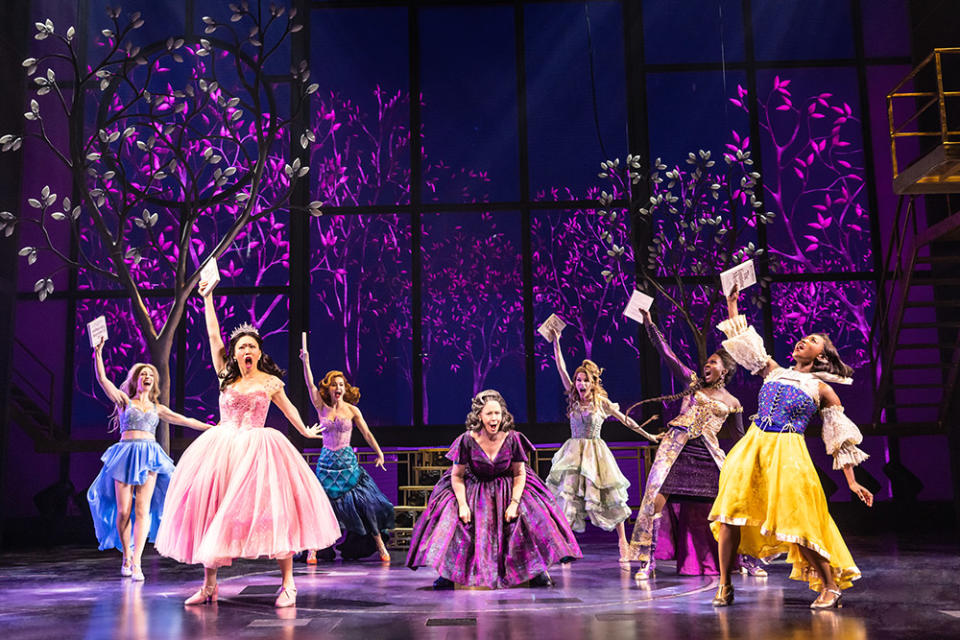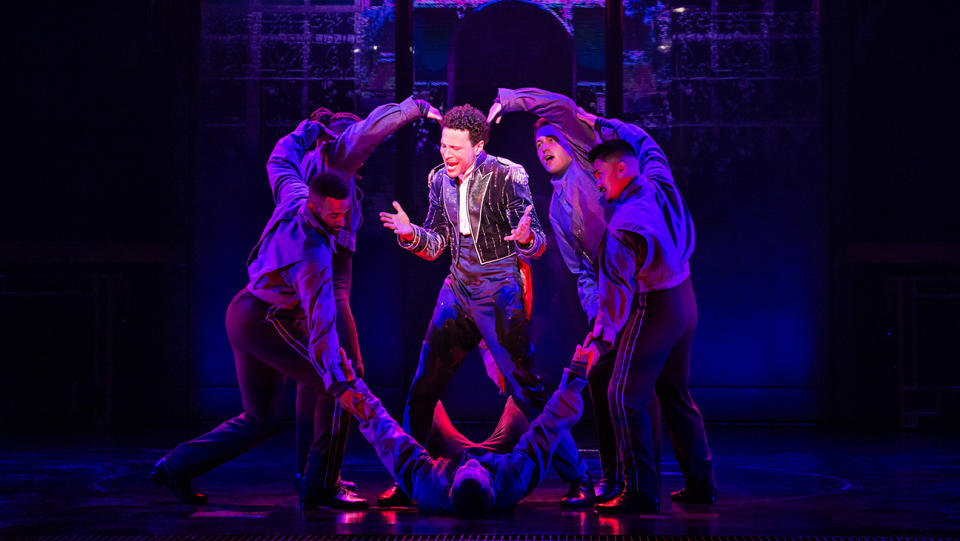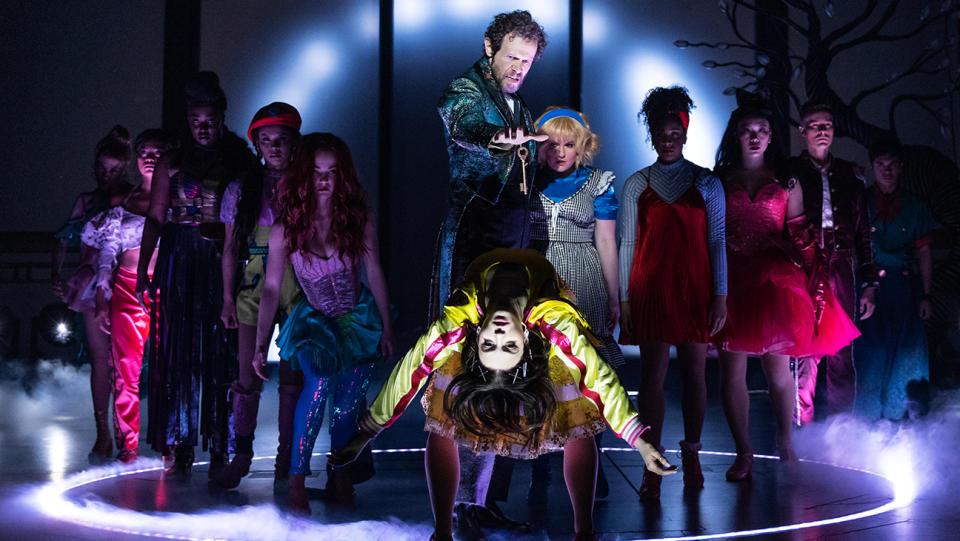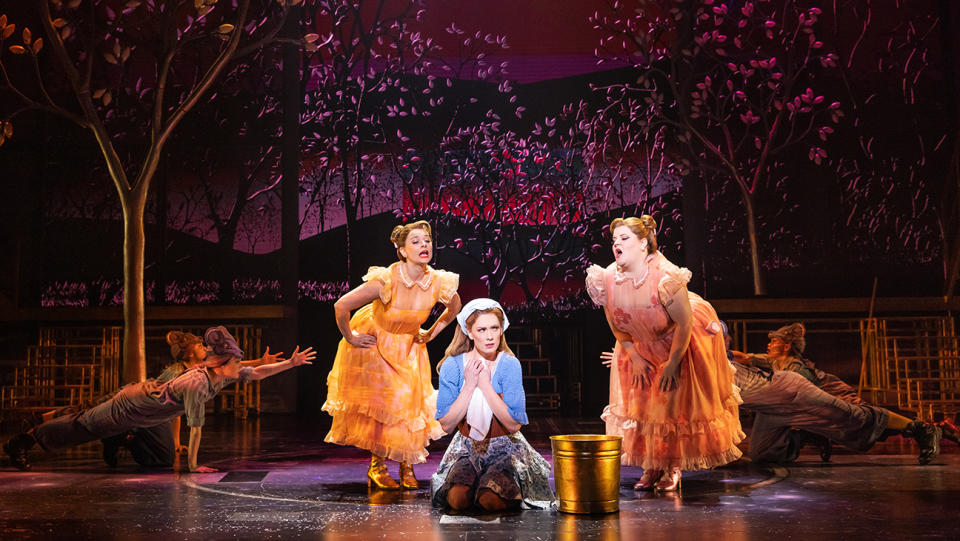How ‘Once Upon a One More Time’ Writer, Choreographers Paid Tribute to Britney Spears
- Oops!Something went wrong.Please try again later.

In Once Upon a One More Time, classic fairy tale princesses meet the catalog of the princess of pop: Britney Spears.
The musical, nearly a decade in the making and supported by the icon herself, opened on Broadway in June, reintroducing the library of one of music’s most influential and enduring pop artist’s to the masses while also giving Spears fans something to scream, shout and let it all out about live and in-person for the first time in years.
More from The Hollywood Reporter
Broadway Has Dropped Vaccine Mandate, COVID-19 Testing Requirements
Alan Arkin, Virtuoso Comic Actor With a Serious Side, Dies at 89
'Camelot,' Featuring a Revised Book By Aaron Sorkin, Announces July Closure on Broadway
Arriving on Broadway alongside several other feminist tales like Six and & Juliet, and ahead of the premiere of Greta Gerwig and Margot Robbie’s Barbie movie, Once Upon a One More Time signals that stories about women taking back control of their narratives are very much in. It’s a fitting message for a musical with the blessing of a singer who won her freedom from a 13-year conservatorship ahead of the musical’s Broadway run, and signed an underlying rights agreement with the production — one of Spears’ first deals signed since the singer was freed from her conservatorship.
The “Oops!… I Did It Again,” “Toxic” and “Circus” singer is credited with the inciting concept behind the musical, which follows classic fairy tale princesses like Cinderella, Snow White, Sleeping Beauty, The Little Mermaid, Belle, Aurora and Rapunzel as they begin to question their existence after reading Betty Friedan’s Feminine Mystique. But it’s the musical’s book writer Jon Hartmere — who spun the story from a spec script he was working on in 2016 — as well as his director-choreographer-duo Keone and Mari Madrid also brought their own distinctive storytelling styles to the Marquis Theatre production.
That creative marriage has kept the musical feeling accessible to both casual and passionate fans of the Grammy-winning artist. Still, eagle-eyed fans may find themselves particularly connecting to the show’s use of butterflies or the unexpected “Curious” perfume joke.
“We’ve always said the intersection between fairy tales and Britney — anything that is inside of that is where we want to pull from,” Keone told The Hollywood Reporter. “It’s hard sometimes to even pluck out what fits in between those two things, and that I think creatively has been the ultimate balance for all of us — to try and figure out when do we serve Britney? When do we serve story? When do those two things work at the same time?”
THR spoke to Hartmere and the Madrids about how they brought their own style to Once Upon a One More Time, while still paying tribute to Spears and her fans.
This is all about a fight for empowerment, agency and self-determined happiness, which Britney Spears feels like she’s always embodied as a singer even beyond the conservatorship narrative. How much of your take was about those broader themes, and how much of it did you want to feel like a direct ode to Spears?
JON HARTMERE That’s why I love them reading The Feminine Mystique. That chapter — “The Problem That Has No Name” — they cannot put their finger on what’s missing, but they know there’s something wrong, and they feel guilty and embarrassed for even asking the question. I love just that dilemma of not even being able to vocalize what you want. That’s such a big, huge step. So for that to then track with what’s been going on in [Spears’] world, it just feels almost preordained as if she herself manifested this because if you looked at the pitch document, that was the pitch.

You’ve got all these Britney Spears references in the production design, in the choreography and in the written story for this — including jokes like the one about Spears’ perfume Curious. How did you think about comedy in terms of those Spears’ references?
HARTMERE The big thing about Curious, was like, “Can we pause for a moment and have the O.F.G. [Original Fairy godmother] wear her perfume? Is that weirdest thing? We’ll just try it.” And the laughter — all I can imagine is what the sales figures are for that perfume because the amount of people who laugh at that, it blows my mind. I thought it’d be a real inside Easter egg, not even Taylor Swift level. A tiny thing that people may or may not get, and yet it’s every night. Of course Brooke [Dillman] is so funny, so she sells, but that’s just pure joy being able to do those winks, and it’s a joy for us how many people are actually receiving them.
You’ve got so many Britney songs here, and you do play with some of the lyrics a bit, but in a way that feels pretty seamless. How did you think about that, considering fans may be really attached lyrically to these songs?
HARTMERE That’s been an ongoing conversation of what is needed because as you said, people are coming in, they know the songs and for me, the only time that I want to change a lyric is if it really serves the story, and where people will be delighted by the change versus frustrated with it, like, “Oh, but I wanted to sing it that way.” But it really just depends on the song. Some songs slot in without any change at all. I think more often than not, you go this actually does work, can we change this one word or have fun with this one line? I love a joke line within a joke moment. But then, with something like “Toxic,” I don’t think there’s a single word changed. We’ve done versions of it before where there were word changes, then you come to learn, actually, let the song do the work.
There’s some dance moments in this show where the audience gets incredibly excited, and it’s clear that they’re responding to some Britney choreography. How much of her original choreography is actually in this show?
KEONE MADRID There’s so much choreography in the show, so it’s hard to remember, but I think the only moment we literally pulled her original choreography is in “Oops!” at the end. Because in my opinion, that move is the most iconic thing. You could do that to anyone, and they’d be like, “Oh, I know what you’re doing,” in some weird way, and that’s why the crowd always freaks out. It’s funny because the choreo for that section starts like a little early and some people catch on, but it’s not until they do that move that everyone freaks out. So that was the only session that we did, and [choreographer] Tina Landon was the one who choreographed it, and we made sure that people are properly credited for that, and that Tina knows. Justin [Guarini] also does a nod to “Slave 4 U.” There might be other things that people unintentionally do.

MARI MADRID I think a lot of it has just been watching, digesting, osmosis and trying to capture the energy and the spirit versus like actually taking from her.
Can you talk about your own influences and how those might have been mixed with hers for this show?
KEONE Growing up, Wade Robson was one of my favorite choreographers. He’s an industry icon in the dance world, and was her choreographer for a good chunk of time. We know a lot of those choreographers who got to work with her, like Brian Friedman, obviously. With us not being from the musical world and from the other side of the entertainment industry, we’re really familiar, so it’s that osmosis thing where we’re able to rely on our instincts of how we would respond to that in a concert sense. We wanted to bring a lot of the live concert sensibility into the work because everyone’s experiencing this live. Also, knowing who she was inspired by, there’s a clear trajectory. If you go back to Michael and Janet [Jackson], then you see Madonna. You can go back and see what elements did she take from them and who did Michael take from. You can go all the way back to [Bob] Fosse. (Laughs.) It’s funny, it always goes back to Fosse, Fred Astaire, Gene Kelly — musical theater. But there’s that roundabout way of how did pop become where it is. We have a deep historical reverence for how movement has come to today, and so I think honoring that and knowing her choreographers early on, and having an osmosis reaction to her work is probably why it might feel that way.
MARI We grew up watching that era of pop music and music videos. That’s when we started dancing, and what we were inspired by. We were just looking at the backup dancers like, “Oh, I want to do that one day.” (Laughs.) So we were always paying attention to what was going on in the movement and these performances and in these videos. So I think it’s just part of us as artists, because that’s kind of where we came from.
How did you marry all of that with your musical’s story, which has this fairy tale theme that’s more indirectly than directly related to the singer?
KEONE I remember learning that original “Oops!” choreography as a young tween side by side with my square TV as it was playing on TRL. So to bring that back and have like a sort of full circle moment to how that inspired our own journey was great. But then to also bring it forward in a contemporary way. We could have easily said let’s do all her choreo, but I think at the end of the day, we have to serve this story. So it’s a combination of bringing in story and the spirit of Britney. How do we keep her spirit alive, even though it’s not exactly something she’s done in the past. An overarching narrative that we wanted to attack was as an artist, she’s so generational. It’s the late ’90s, early 2000s, the 2010s and so forth. She’s reached so many different ages and people. Pop from a pure language standpoint has evolved.
We talked about the earlier VMAs and the award shows, where the set design was wacky, and the costumes had like one sleeve cut off on a blazer and wristbands — the random colorful stuff. (Laughs.) So we tried to fuse that energy into the early onset of the show, in act one, and then when it contemporizes itself in the arc of the narrative, it becomes a little bit more monochromatic, like something you might see in a Billy Eilish concert or in a Kendrick Lamar concert. But putting the spirit of Britney at the forefront of it all. That was a good compass for us to attack this thing, so we were able to make more clear choices as opposed to being overwhelmed by every number and creating languages within the show. Because it was about how did the princesses move? Our stepmother, stepfamily, the narrator — all the languages within the characters inside this fairy tale.

MARI Also, just musically, we wanted it to be able to change and evolve with the princesses. So in act one, there are so many songs, and we really tried to stay true to her music and not change much. But we were super inspired going back and watching a lot of her live performances because she has like dance break on dance break on remix. We’re dancers, so we love and want all of that, and we wanted to be able to fuse that energy into the story. But I think as the women start to evolve and change, we wanted the music to also do that, which comes to a head and “Toxic,” which is very different from the original. So we had to be careful about that because we have to pay tribute to her music and keep the essence of it, while also, like Keone said, stay with the story. You’ll get little hints of the difference. The first time the music steps out of that is when Cinderella’s dress transforms, and you get maybe a four-eight count section where it changes and then it’ll go back. “Crazy” we leaned in a little bit and came back and then “Toxic” that’s where it comes to a head where we kind of pushed all the way to find a different sound that felt a little bit more like today, which was a risk, we know, because it’s a big hit.
Can you share your favorite Easter eggs, including something fans might not immediately notice?
HARTMERE I do think that every department has put in at least one wink or a nod because everybody does their homework. In terms of real Easter eggs, we have a dwarf named Clumsy and Spears has a song named “Clumsy” that is a deep, deep cut that she wrote herself. I don’t know what percent of the audience clocks that. I find it delightful. The Curious thing, that we talked about earlier, hits much harder than I thought it would. We’ve got a line where one of the stepsisters named Betany corrects the narrative when she’s misnamed and says, “It’s Betany, bitch.” Obviously, people get that, too. There’s just things sprinkled throughout, and it depends on what percent of the people get it. In “Crazy,” when the narrator yells stop, I don’t think a high percent of the audience gets it, but the people who get it really are delighted by it, and I’m delighted by it, and it works even if you don’t get it. It makes perfect sense within the show.

KEONE A lot of the dance breaks a lot of the opening scores — the opening of “Crazy” and even in the ball where we did “Boys” but a girls’ rendition — all have come from a single Britney concert in St. Louis; a single Britney concert that she did for a radio show; this old video of her before she was even huge, when she was young Britney. She did live performances so much, and she was never afraid to reinvent her music inside of those concerts. It was such a compass for us. We don’t only have the song available to us, but we have her catalog in terms of all the work that she’s done — that orchestration in that concert. So literally everything orchestration-ly — and the music team has really latched on to this idea, too — is putting all of that in there. Even “Stronger,” we reinvented it, and it’s subtle, but it punches a little bit more like her AMA’s performance versus her actual track. We have that foghorn in there in a subtle way that tells a story. There’s so many nooks and crannies and sounds that we’re really happy about. If people know, they know, and I feel audiences will feel like this is from people who really watched Britney’s work and had their hands on this project.
What have been the challenges of this for you all, especially as folks newer to the musical industry?
HARTMERE For me, it’s just been how long it’s taken to get here — it’s felt a bit like Christmas morning, but the clock has stopped, and I don’t just mean with COVID. I was so excited to get this out there, but when I look back, if we had done that very first version, I wouldn’t even know Keone and Mari, who are the most delightful, amazing humans on the planet. We wouldn’t have some of the cast. We wouldn’t have changes that we made. So the patience paid off, but I think it’s just been challenging to be patient and let the process unfold in whatever way it was supposed to.
MARI I haven’t processed everything, and it’s kind of happened in waves. It’s been in our lives now for five years. We’ve been thinking about this, and having so many conversations and I kind of don’t even believe that the moment is even here that we’re getting to share it with people. Also that we have to stop working on it. At a point, you have to let go of the thing that you created, especially after spending so much time investing in it and working on it and tinkering with it. But I think it’s been so wonderful to go into the audience every night and feel people interacting with it. The last handful of years has been so crazy for humanity, so to be able to be in a room with people in person and feel joy is it’s just so refreshing.
KEONE We’re all learning so much about ourselves and learning so much about this industry, along with balancing the Britney and the Broadway of it all. And like any jukebox musical, they go through that challenge, bending music to their will to make it work for whatever they’re trying to say. I said in another conversation that I was thinking about this interview that I saw of Britney early on from her real peak days, and it’s a time where reporters would ask her the nastiest questions.
MARI She was really young.
KEONE They would ask her nasty questions about her that were so off-putting, but to see her just remain calm — answer and calmly correct people — and still be kind throughout at all, I think that was just a clear compass for us of like what her spirit is in terms of what she stands for, and how do we do that inside of the making of the show with each other as humans. Then how do we try and exert that to an audience, so that they leave feeling like they can treat each other with joy and happiness and kindness and all the things that she stood. Because it got ugly for a while, in terms of the conservatorship and everything. But we all just wanted her to be happy and live a free life, and we’re so happy that we’re able to get the confirmation that she was supporting the show post conservatorship so that we can support her fully by creating this work wholeheartedly and stand for the things that she directly stood for.
Interview edited for length and clarity.
Best of The Hollywood Reporter

